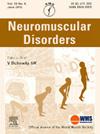220VP 在现实环境中评估和监测神经肌肉患者的可穿戴传感器
IF 2.7
4区 医学
Q2 CLINICAL NEUROLOGY
引用次数: 0
摘要
可穿戴式传感器在补充步态缺陷的标准临床评估和远程监控患者运动功能方面越来越受欢迎。在 6MWT 过程中对步态进行监测为研究长时间行走过程中发生的动态变化提供了机会。此外,在家中进行连续监测还能了解患者的日常运动情况。我们的首要目标是确定肌张力营养不良症(MD)患者在持续行走过程中步态参数是否会恶化。我们的第二个目的是评估在日常生活条件下获取体力活动生物标志物的可行性。我们收集了 30 名患有肌营养不良症的患者的数据,他们在标准的 6MWT 中佩戴了一个位于 L5 水平的传感器(GSensor,BTS)。我们从原始信号中提取了与 6MWT 早期、中期和晚期相对应的步态参数,并应用非参数检验对步态分段进行了比较。我们将使用可穿戴传感器(DynaPort 7,麦克罗伯茨公司)进行连续 7 天的家庭监测,以提取体力活动数据。初步结果显示,在 6MWT 早期和晚期部分之间,MD 组的步态加速度增加,步态的平稳性和稳定性也发生了显著变化。我们的初步结果表明,使用可穿戴设备可以在 6MWT 过程中测量与疲劳相关的步态参数,而且这种方法可以突出显示 MD 患者在 6MWT 阶段的变化。在神经肌肉疾病患者的生态环境中对其进行评估,可对旨在促进积极生活方式的康复管理产生重大影响。本文章由计算机程序翻译,如有差异,请以英文原文为准。
220VP Wearable sensors to evaluate and monitor neuromuscular patients in real world environment
Wearable sensors are becoming increasingly popular for complementing standard clinical assessments of gait deficits and for remote monitoring patient's motor function in real world. Monitoring gait during the 6MWT offers an opportunity to investigate the dynamic changes that occur in prolonged walking. Besides, continuous monitoring at home gives information on patient's daily physical activity. Our first aim is to determine if gait parameters worsen during sustained walking in patients affected by myotonic dystrophy (MD). Our secondary aim is to evaluate the feasibility of acquiring physical activity biomarkers in daily living conditions. We collected data of 30 patients with MD during a standard 6MWT wearing a sensor (GSensor, BTS) at L5 level. Gait parameters were extracted from raw signals, corresponding to early, middle and late segments of the 6MWT and we applied non-parametric tests to compare gait segments. Home monitoring for extraction of physical activity data will be performed using a wearable sensor (DynaPort 7, McRoberts) worn consecutively for 7-days. Preliminary results show an increase in gait acceleration and significant changes in smoothness and stability of gait in the MD group between the early and the late section of the 6MWT. Our preliminary results suggest that gait parameters associated to fatigability can be measured during a 6MWT using a wearable device and that the method allows to highlight variations during sections of the 6MWT in patients with MD. Evaluating patients with a neuromuscular disease in their ecologic setting could significantly impact rehabilitation management with the aim of promoting an active lifestyle.
求助全文
通过发布文献求助,成功后即可免费获取论文全文。
去求助
来源期刊

Neuromuscular Disorders
医学-临床神经学
CiteScore
4.60
自引率
3.60%
发文量
543
审稿时长
53 days
期刊介绍:
This international, multidisciplinary journal covers all aspects of neuromuscular disorders in childhood and adult life (including the muscular dystrophies, spinal muscular atrophies, hereditary neuropathies, congenital myopathies, myasthenias, myotonic syndromes, metabolic myopathies and inflammatory myopathies).
The Editors welcome original articles from all areas of the field:
• Clinical aspects, such as new clinical entities, case studies of interest, treatment, management and rehabilitation (including biomechanics, orthotic design and surgery).
• Basic scientific studies of relevance to the clinical syndromes, including advances in the fields of molecular biology and genetics.
• Studies of animal models relevant to the human diseases.
The journal is aimed at a wide range of clinicians, pathologists, associated paramedical professionals and clinical and basic scientists with an interest in the study of neuromuscular disorders.
 求助内容:
求助内容: 应助结果提醒方式:
应助结果提醒方式:


